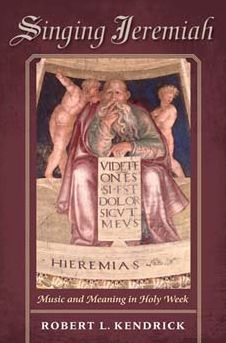Singing Jeremiah: Music and Meaning in Holy Week
A defining moment in Catholic life in early modern Europe, Holy Week brought together the faithful to commemorate the passion, crucifixion, and resurrection of Jesus Christ. In this study of ritual and music, Robert L. Kendrick investigates the impact of the music used during the Paschal Triduum on European cultures during the mid-16th century, when devotional trends surrounding liturgical music were established; through the 17th century, which saw the diffusion of the repertory at the height of the Catholic Reformation; and finally into the early 18th century, when a change in aesthetics led to an eventual decline of its importance. By considering such issues as stylistic traditions, trends in scriptural exegesis, performance space, and customs of meditation and expression, Kendrick enables us to imagine the music in the places where it was performed.
1114772466
Singing Jeremiah: Music and Meaning in Holy Week
A defining moment in Catholic life in early modern Europe, Holy Week brought together the faithful to commemorate the passion, crucifixion, and resurrection of Jesus Christ. In this study of ritual and music, Robert L. Kendrick investigates the impact of the music used during the Paschal Triduum on European cultures during the mid-16th century, when devotional trends surrounding liturgical music were established; through the 17th century, which saw the diffusion of the repertory at the height of the Catholic Reformation; and finally into the early 18th century, when a change in aesthetics led to an eventual decline of its importance. By considering such issues as stylistic traditions, trends in scriptural exegesis, performance space, and customs of meditation and expression, Kendrick enables us to imagine the music in the places where it was performed.
50.0
In Stock
5
1

Singing Jeremiah: Music and Meaning in Holy Week
352
Singing Jeremiah: Music and Meaning in Holy Week
352
50.0
In Stock

Product Details
| ISBN-13: | 9780253011565 |
|---|---|
| Publisher: | Indiana University Press |
| Publication date: | 05/05/2014 |
| Series: | Music and the Early Modern Imagination |
| Pages: | 352 |
| Product dimensions: | 6.40(w) x 9.40(h) x 1.10(d) |
| Age Range: | 18 Years |
About the Author
What People are Saying About This
From the B&N Reads Blog
